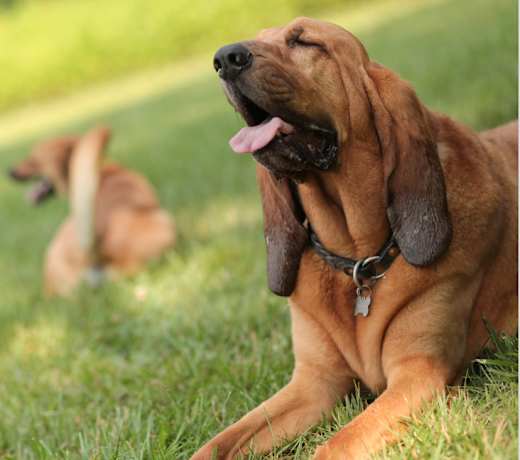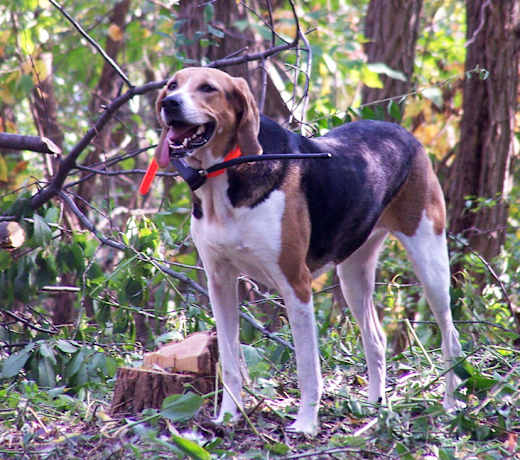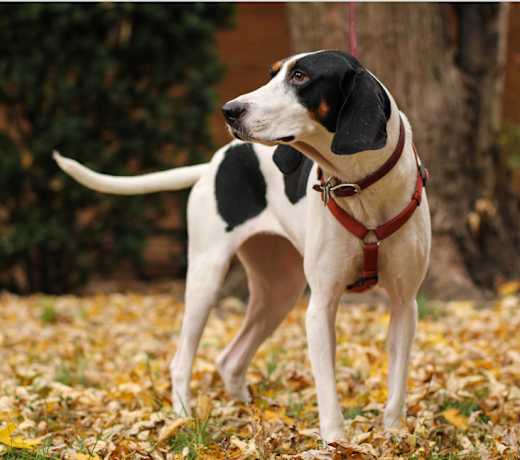Redbone Coonhounds stop growing in height and reach their full adult size between 12 and 18 months of age. However, they might continue to fill out and gain muscle mass until they are around two years old.
Redbone Coonhound
Breed Type: Hound
Common nicknames: Reds, Redbone
Coat: Smooth
Hypoallergenic: No, they will likely trigger allergies.
Temperament: Vocal, friendly, affectionate, energetic
Life expectancy: 12-15 years
Color & patterns: Red
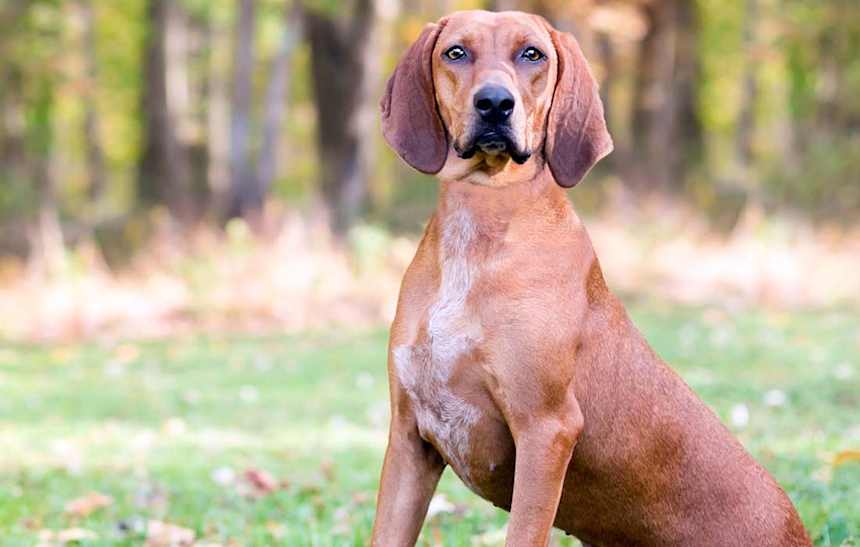
Redbone Coonhounds have striking red coats and soulful eyes and exude charm. They’re also versatile: Whether you’re seeking a skilled hunting partner or a loving family pet, the Redbone Coonhound fits the bill. This breed is known for their excellent scenting abilities and strong tracking instincts and is a favorite among hunters. But don’t let their working prowess fool you — Redbone Coonhounds are also affectionate and loyal companions. They thrive on human companionship and are eager to be a part of the family, always ready to join in on adventures.
Redbone Coonhound characteristics
Learn about about Redbone Coonhound basics like their fur colors, shedding levels, how much grooming they need, and other Redbone Coonhound facts.
Average height
21-27 inches (53.3-68.6cm)
Average weight
49-90 pounds (22.2-40.8 kg)
Average lifespan
12-15 years
Exercise needs
Grooming needs
Full-grown size
Good with cats
Good with kids
Training aptitude
How long do Redbone Coonhounds live?
Redbone Coonhounds typically live between 12 and 15 years. Their lifespan can be influenced by various factors, including genetics, diet, exercise, and overall health care. Regular veterinary check-ups, a balanced diet, and proper exercise can help ensure they live a long and healthy life.
How big do Redbone Coonhounds get?
Redbone Coonhounds are a medium to large breed. Males are usually 22 to 27 inches tall at the shoulder. Females are slightly smaller, between 21 and 26 inches tall. Adult Redbone Coonhounds generally weigh between 45 to 70 pounds.
Do Redbone Coonhounds shed?
Yes, Redbone Coonhounds shed, but their shedding is generally moderate. The short, smooth coat sheds throughout the year, with more noticeable shedding in the spring and fall. Brushing once a week can help manage shedding.
Redbone Coonhound temperament
Learn about about the Redbone Coonhound temperament and how well they fit into your lifestyle, home environment, and family.
Are Redbone Coonhounds good with kids?
Yes, Redbone Coonhounds are good with kids. They are usually affectionate and patient, which helps them get along well with children. Redbone Coonhounds are active and playful, which can make them great playmates for kids who enjoy outdoor activities. They tend to be tolerant of a child’s playful behavior, though parents should always supervise interactions to ensure both the dog and children interact safely.
As with any breed, it’s important to teach children how to interact respectfully with dogs. Early socialization and positive experiences with children can help ensure that Redbone Coonhounds develop into well-adjusted family pets.
Are Redbone Coonhounds good with cats?
Redbone Coonhounds can get along with cats, but it often depends on the dog’s individual temperament and proper introductions. Redbone Coonhounds have strong hunting instincts, which means they might have a high prey drive. This can sometimes lead to chasing or hunting behaviors, particularly toward smaller animals like cats.
Introducing a Redbone Coonhound to a cat in a controlled manner can improve the chances of them getting along, especially when this is done at a young age. With the right approach, many Redbone Coonhounds can coexist peacefully with cats.
Do Redbone Coonhounds bark a lot?
Yes, Redbone Coonhounds bark a lot. Like most hunting hounds, the Redbone Coonhound uses barking and baying to communicate while tracking game, so they can be quite vocal, especially when they pick up a scent or when they’re excited.
In a home setting, Redbone Coonhounds might bark or bay to alert to the presence of strangers, to express excitement, or when they’re bored. They’re not usually excessive barkers without cause, but they do have a strong tendency to vocalize, which is something to consider if you live in an area where noise could be an issue.
Are Redbone Coonhounds good family dogs?
Yes, Redbone Coonhounds are good family dogs. They are friendly, affectionate, and devoted, with boundless enthusiasm and energy. They thrive in active families that can provide them with the physical exercise and mental engagement they need.
Are Redbone Coonhounds easy to train?
No, Redbone Coonhounds are not easy to train compared to some other breeds. Although they are intelligent, Redbone Coonhounds can sometimes be a bit stubborn or distracted, particularly when their hunting instincts are triggered. Redbone Coonhounds respond well to positive reinforcement, such as treats, praise, and playtime. Training sessions that are engaging and rewarding will be more effective. However, keep in mind that training any dog takes substantial time and effort, regardless of breed.
Redbone Coonhound health
Learn about about the Redbone Coonhound health outlook and what diseases they may be prone to at various stages of their life.
Do you need to groom a Redbone Coonhound?
Yes, you need to groom a Redbone Coonhound, though their grooming needs are relatively low compared to some other breeds. Their short, smooth coat benefits from weekly brushing with a rubber curry brush or a hound glove. Unless they get very dirty, Redbone Coonhounds need a bath every couple of months or as needed.
Due to their long, floppy ears, Redbone Coonhounds are prone to ear infections. Regular ear checks and cleaning are essential to prevent buildup of wax, dirt, and moisture. Trim their nails every three to four weeks and brush their teeth daily to prevent dental disease.
Do Redbone Coonhounds have a lot of health problems?
No, Redbone Coonhounds do not have a lot of health problems. Although they are generally healthy and robust, like all breeds, they can be prone to certain health issues. Regular veterinary check-ups, a balanced diet, and proper exercise can help maintain their health and catch any potential issues early.
What diseases are Redbone Coonhounds prone to?
Redbone Coonhounds are prone to several diseases and health conditions. Some of the more common ones include:
Hip dysplasia: A genetic condition where the hip joint doesn’t fit properly into the hip socket, which can cause pain and arthritis over time.
Elbow dysplasia: Similar to hip dysplasia, elbow dysplasia affects the elbow joint, leading to joint pain and lameness.
Ear infections: Due to their floppy ears, Redbone Coonhounds are more susceptible to ear infections. Regular ear cleaning and checks can help manage this risk.
Hypothyroidism: A condition where the thyroid gland produces insufficient thyroid hormone, which can lead to weight gain, lethargy, and skin problems.
Gastric dilatation-volvulus (bloat): A serious condition where the stomach fills with gas and can twist, requiring immediate medical intervention.
Cancer: Redbone Coonhounds can be prone to various forms of cancer, including lymphoma and other tumors.
Progressive retinal atrophy (PRA): A genetic condition that can lead to vision loss and blindness over time.
Von Willebrand disease: A genetic bleeding disorder that affects the blood’s ability to clot properly.
Are Redbone Coonhounds hypoallergenic?
No, Redbone Coonhounds are not hypoallergenic. They shed moderately, and their short, smooth coat can release dander into the environment, which might trigger allergic reactions in sensitive individuals. If you or someone in your home has allergies, spend time with a Redbone Coonhound before adopting to see if there are any allergic reactions.
Redbone Coonhound history
Learn about where the Redbone Coonhound came from.
Where are Redbone Coonhounds from?
Redbone Coonhounds originated in the United States, specifically in the southern states. They were developed in the late 18th and early 19th centuries by American hunters who wanted a versatile and reliable hunting dog. The breed is thought to have descended from red Foxhounds brought to America by Scottish and Irish immigrants, which were then bred with other Coonhounds and Bloodhounds. The breed was refined to excel at hunting raccoons and other game across difficult terrain. They are known for their strong scent-tracking abilities, stamina, and distinctive red coat.
What colors do Redbone Coonhounds come in?
Redbone Coonhounds have a solid red coat without significant markings. Small amounts of white are acceptable on the chest or toes, but solid red coats without white markings are preferred in terms of the breed standard.
Popular Redbone Coonhound mixes
Redbone Coonhounds are sometimes mixed with different breeds. Some common mixes involving Redbone Coonhounds include:
Redbone Coonoodle (Redbone Coonhound + Poodle)
Redbone Lab (Redbone Coonhound + Labrador Retriever)
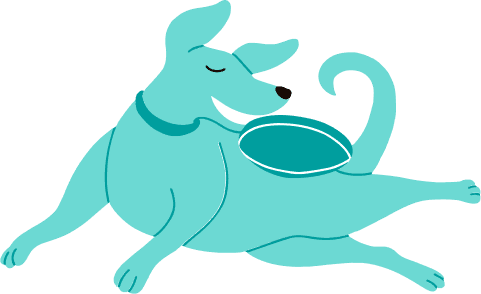
Find Redbone Coonhound puppies near you
Adopting a Redbone Coonhound
Learn about acquiring a Redbone Coonhound - the pros and cons of adopting versus going through a breeder, and associated costs.

ZOEY
Redbone Coonhound
Female, 4 yrs 1 mo
Long Beach, CA

ZOEY
Redbone Coonhound
Female, 4 yrs 1 mo
Long Beach, CA

